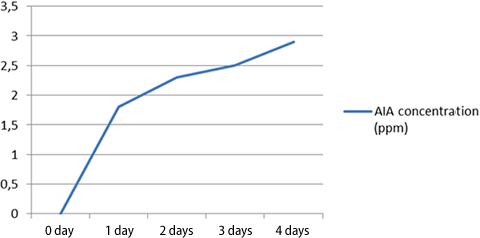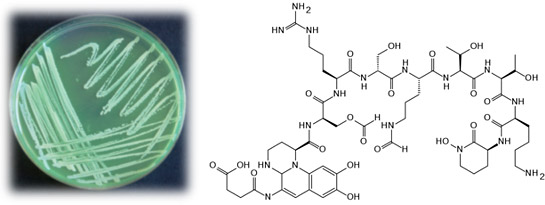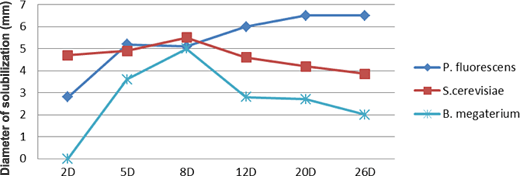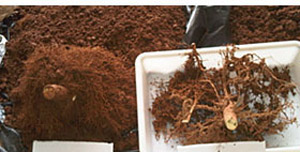Our microbial inoculants are feed products which contain high purity and concentration biomass. They are PGPR (Plant Growth promoting Rhizobacteria)combinations or microbial consortia which lie dormant. Each strain has been selected, isolated and deposited in a culture collection of restricted use in the Spanish Type Culture Collection.
Characterised strains property of IAB
Azotobacter vinelandii strain IAB/AV/02 (CECT 7655)
Bacillus amyloliquefaciens strain IAB/BA/01 (CECT 7657)
Bacillus subtilis strain IAB/BS/03 (CECT 7254)
Bacillus subtilis strain IAB/BS/F1 (CECT 8381)
Pseudomonas fluorescens strain IAB/PF/05 (CECT 7255)
Rhizobium leguminosarum strain IAB/RL/05 (CECT 7656)
Saccharomyces cerevisiae strain IAB/SC/03 (CECT 13050)
Trichoderma harzianum strain IAB/TH/01 (CECT 20758)
They all are natural strains isolated by IAB, non modified by genetic engineering and characterised by molecular biology.
Azotobacter vinelandii strain IAB/AV/02 (CECT 7655)
Mechanisms of action:
- Free living atmospheric nitrogen fixation (Nitrogenase): A 108 ufc Azotobacter /g root which has a fixation efficiency of 10-60 kg/ha/year.
- AIA production: It promotes positive phototropism. It makes lateral and adventitious roots grow and supports flowering and the fruit ripening.
AIA concentration (ppm)

Bacillus subtilis strain IAB/BS/F1 (CECT 8381)
Mechanisms of action:
- Organic matter degrader (enzymatic)
- It promotes the nutrients absorption.
- It improves the resistance to adverse environmental factors.
- It is a promoter of aerial and root system growth and helps the seed germination.
- Giberelines production (GA3): the rate of cell division increases.
- Solubilization of phosphates: by means of organic acids secretion and phosphomonoesterase production.
Pseudomonas fluorescens strain IAB/PF/05 (CECT 7255)
Mechanisms of action:
- It reduces the susceptibility to frosts and improves the tolerance to soil salinity.
- It estimulates the seed germination and the sprouting of seedlings, accelerates the growth in transplants, increases the roots and root hairs formation.
- It inhibits the ethylene synthesis: it produces the increase in roots length.
- It synthesizes the plant growth regulators: production of phytohormones (auxins, cytokines and giberelines)
- Producer of pyoverdine.

Rhizobium leguminosarum strain IAB/RL/05 (CECT 7656)
Mechanisms of action:
Mechanisms of action: atmospheric nitrogen fixer in a symbiotic way with leguminous plants. Specifically for:
- Cicer sp.: Chickpeas
- Lathyrus sp. : Almortas (grass peas)
- Pisum sp.: Peas
- Lens sp.: Lentils
- Vicia sp.: Beans, carobs, vetch
Saccharomyces cerevisiae strain IAB/SC/03 (CECT 13050)
Mechanisms of action:
- Organic matter degrader for the release of amino acids, vitamins, minerals, etc in both aerobic or anaerobic conditions
- Highly potent solubiliser for insoluble phosphates

From the point of view of the PGPR’s the shared use of different microbial combinations is a key to success of the use of beneficial interactions between plants and microorganisms.
The main aim is the synergy between different strains to increase their modes of action and the capacity feasible and adaptable to the different environmental factors.
That is why IAB manufactures products which combine different compatible microorganisms that cause biofertilizing or bio-stimulant effects for the plant growth with a synergic way of acting in plants. We are talking about INOMIX SERIES:
Inomix Biofertilizer
It is a solid product with a minimum quality of 1010 cfu/g (colony forming units per gram) that has been designed as an active matter for biofertilizer microbial inoculants used for formulations which target the improvement of rizosphere fertilization.
It contains a mixture of bacteria and yeast natural strains especially selected by IAB, which have not been modified by genetic engineering, and deposited with the Spanish Type Culture Collection (CECT) with restricted use. They have got the following numbers:
CECT 7253: Bacillus subtilis (IABBSF1)
CECT 13050: Saccharomyces cerevisiae (IABSC03)
CECT 7655: Azotobacter vinelandii (IABAV02)
CECT 7656: Rhizobium leguminosarum (IABRL05)
The product has been designed for soil application, so that it can bring a biofertilizing action by means of nitrogen-fixer bacteria, both symbiotic (Rhizobium legumnosarum) or non symbiotic (Azotobacter vinelandii), bacteria and yeasts which are inorganic phosphorous mobilisers (Bacillus subtilis and Saccharomyces cerevisiae) able to break down sugars and complex nitrogen compounds so that they can be easily assimilated by the plant. These microorganisms are also capable of synthesizing other beneficial substances for the plant growth such as the auxins.
Inomix Phosphorous
It is a solid product with a minimum quality of 1010 cfu/g (colony forming units per gram) that has been designed as microbial inoculants active matter capable of mobilizing the soil inorganic phosphorous and the complex matter as it releases sugars and nitrogen compounds so that they can be absorbed by the plant, as well as the iron needs of the plant in an assimilable way. It has been designed as an active matter for microbial inoculants with a stimulating action for the plants growth used for formulations targeting the soil treatment for the improvement of plants yield and for the development of formulations whose purpose is the improvement of the rhizosphere fertilization. It also provides a large plants growth by giving them assimilable nutrients as well as synthesizing phytohormones which stimulate the roots growth, supporting water and nutrients absorption, improving plants tolerance in adverse conditions and enhancing the soil structure biodiversity and, consequently, more vigorous and productive plants are achieved.
It contains a mixture of bacteria and yeast natural strains especially selected by IAB, which have not been modified by genetic engineering, and deposited with the Spanish Type Culture Collection (CECT) with restricted use. They have got the following numbers: CECT 7253: Bacillus subtilis (IABBSF1)
CECT 7253: Bacillus subtilis (IABBSF1)
CECT 7255: Pseudomonas fluorescens (IABPS05)
CECT 13050: Saccharomyces cerevisiae (IABSC03)
Solubilization of inorganic phosphate


